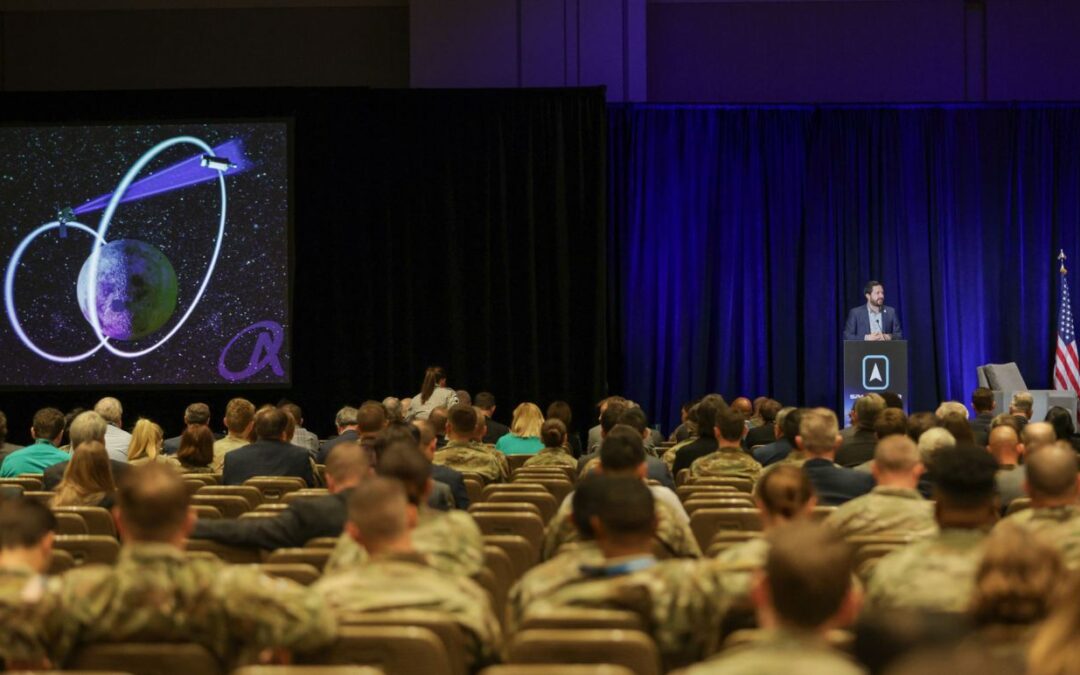Taking the Space Force Seriously
In December, Bradley Cheetham, CEO, Dave Jungkind, Chief Revenue Officer & Special Program Lead, and Bart Leahy, Senior Technical Writer, attended Spacepower. Dave Jungkind shares his perspective on Space Force in the industry. The United States Space Force (USSF) came into being December 20, 2019. Happy belated birthday to our newest service and Semper supra! This past month, The US Space Force Association (SFA), the industry and volunteer community of the Space Force, put together their first conference in Orlando: Spacepower. It was an engaging gathering and Advanced Space was honored to sponsor and attend the conference.
Four years into its existence, the Space Force is still defining itself, having released a new mission statement this past September: “Secure our nation’s interests in, from, and to space.” They are also working out the necessary training, pay scales, and promotion standards for its personnel, called “guardians.” They even have their own song!
However, while these internal matters are being worked out, the Space Force leadership made clear that they consider themselves a fighting force with a vital, public role to play in U.S. military operations today. Most Space Force activity is Earth-facing to support the other services in land, sea, and air operations. They recognize space superiority as a key enabler and force multiplier of United States military superiority, and the primary theme one heard from the General Officers speaking at the event was that the Space Force was positioning itself to deter China and Russia from aggressive actions in space.
Changing the Nature of Space Assets
As we do with any industry conference, Advanced Space was there to learn about the mission and how we could best contribute to the Space Force’s success. In the current environment, where technology and tensions are increasing, small businesses with nimble execution like ours might have an advantage. To paraphrase Space Force leadership comments, “slow and steady might win the race in children’s books, but that is not how we are going to operate. We will be fast and first.”
The Space Force is trying to overcome some institutional inertia from its parent service, the Air Force—what one speaker called “five decades of bureaucratic plaque.” Given its Cold War birth and focus, the USAF focused on large, exquisite, monolithic satellites designed to do one thing, at a high cost ($500M-$1B per spacecraft), with operating cycles lasting 10-20 years. With this structure in mind, satellites often were outdated as soon as their requirements were finalized.
The new model the Space Force is striving for is a three-year development cycle that integrates the latest technologies. The service is seeking technological capabilities that provide overwhelming advantages over rival powers with the ultimate goal to deter anyone from starting a direct conflict with the U.S. or its allies. As a result, they are trying to speed up the service’s adoption of new technologies. This includes acquiring existing commercial capabilities, procuring new capabilities, or (less often) developing them in-house.
How Businesses Can Help the Space Force Mission
The Space Force has been seeking a variety of new capabilities through multiple channels, including the Space Systems Command (SSC), the U.S. Space Command (SPACECOM), and the Space Development Agency (SDA), as well as in partnership with elements from their parent service like the Air Force Research Laboratory (AFRL). Together, these organizations are releasing solicitations and Small Business Innovation Research (SBIR) opportunities in a wide range of fields to leverage the creativity, rapid development, and lower cost of smaller space assets. This is another change from the Cold War: rather than dictating requirements or technologies that could obsolesce quickly, the Space Force is stating the problems they need to solve and letting private industry apply the latest tools to solve them.
Advanced Space already operates in several of the fields the Space Force needs, such as improving command and control (C2) tools; applying artificial intelligence and machine learning to existing problems, such as navigation and on-orbit autonomous mission operations; and developing more flexible and capable spacecraft.
Large businesses benefit from the new approach, too. In an effort to improve support to ground, sea, and air forces, Space Force contractors such as Lockheed Martin and Northrop Grumman are being awarded, developing, or launching whole new layers of communication, data transport, and missile warning satellites for the SDA. These layers, coming out in three-year funding intervals (tranches), are set up to take advantage of new technologies as they become available, shrinking the typical Department of Defense acquisition cycle in a way never attempted before.
Beyond the specific opportunities, the Space Force is relying on private industry to develop new technologies rapidly (and on time, when they’re on contract) and to share their best and brightest people and ideas when the opportunities arise. One general called our current environment “an age of aggressive advancement.” And with more small businesses creating new technologies to respond to specific problems, it’s becoming clear that one organization can no longer expect to develop and maintain single, monolithic systems to meet overall Space Force mission needs. Businesses large and small are going to have to learn how to play nicely with others, including our “competimates,” to meet the Space Force’s challenging objectives. Everything will have to move faster; produce, protect, and interpret more actionable data; and be robust and adaptable enough to respond to the warfighters’ needs when they need them.
Advanced Space is ready to play in this arena. Are you?
